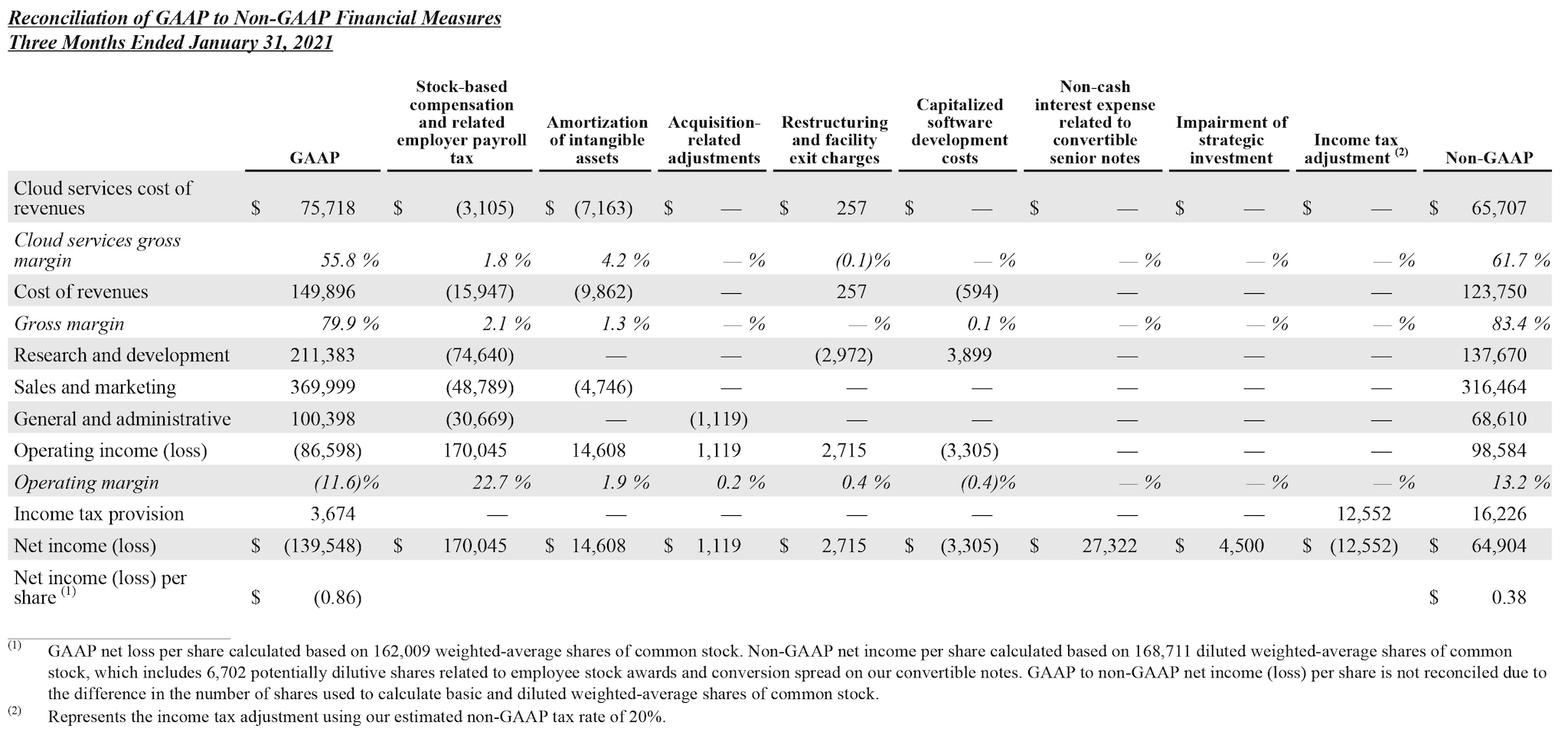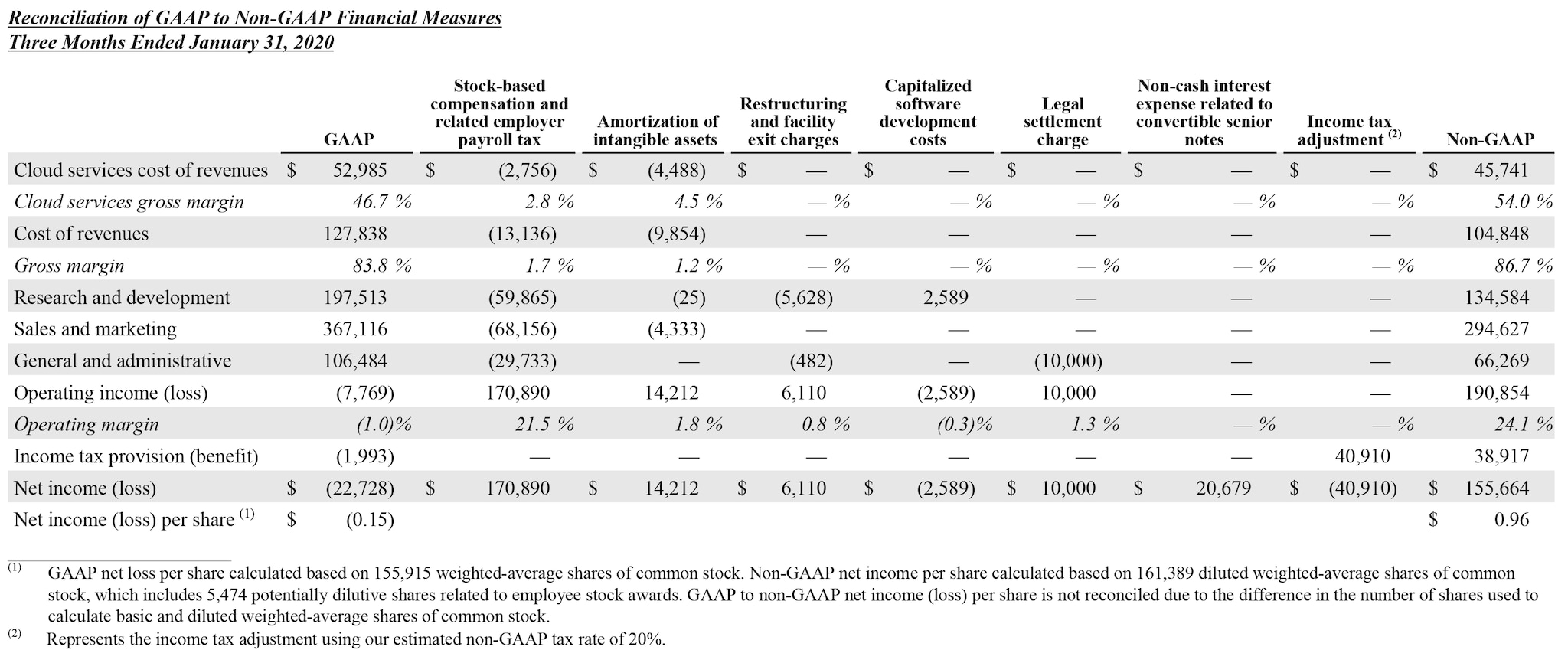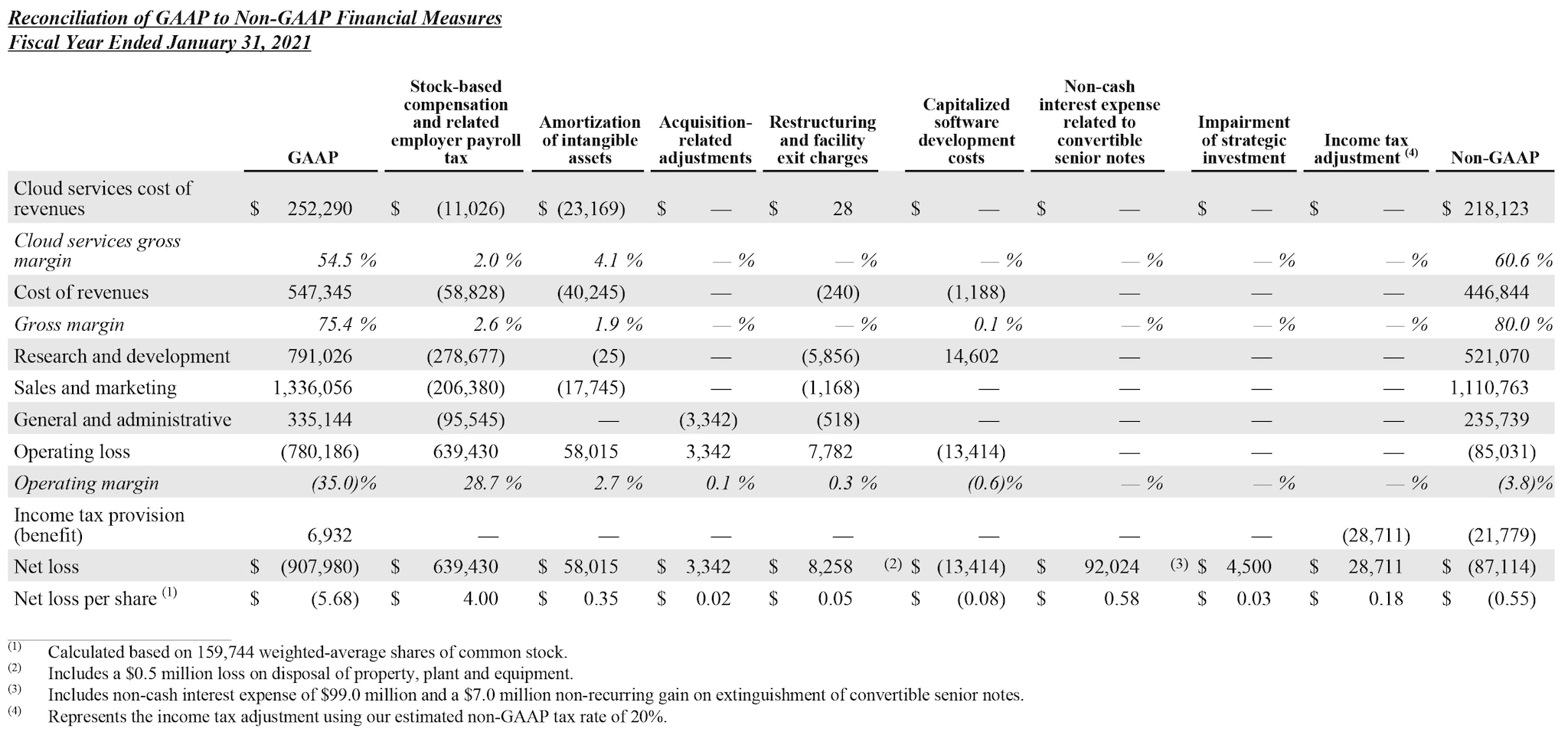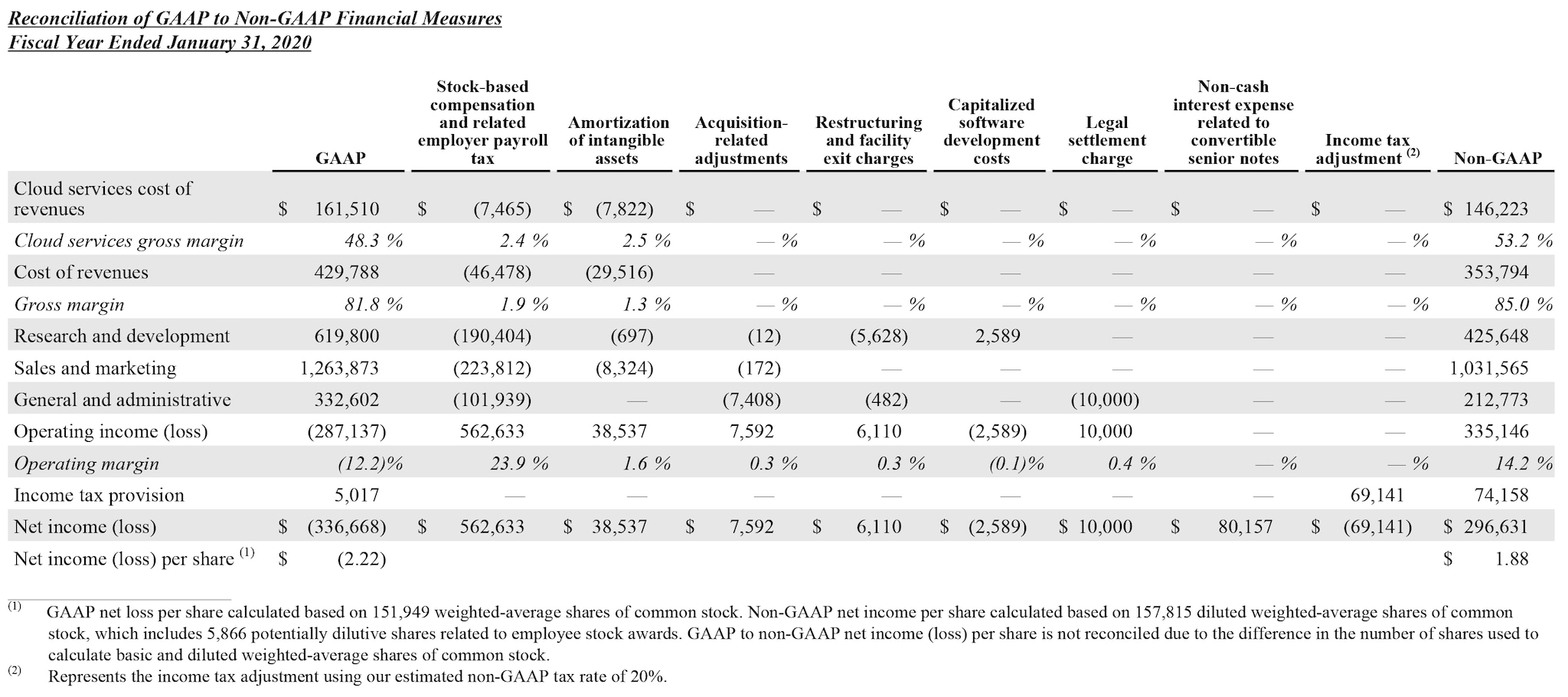SAN FRANCISCO – March 3, 2021 – Splunk Inc. (NASDAQ: SPLK), provider of the Data-to-Everything Platform, today announced results for its fiscal fourth quarter and full year ended January 31, 2021.
Fourth Quarter 2021 Financial Highlights
- Cloud ARR was $810 million, up 83% year-over-year.
- Total ARR was $2.36 billion, up 41% year-over-year.
- Cloud revenue was $171 million, up 72% year-over-year.
- Total revenues were $745 million, down 6% year-over-year.
- 510 customers with ARR greater than $1 million, up 44% year-over-year.
Full Year 2021 Financial Highlights
- Cloud revenue was $554 million, up 77% year-over-year.
- Total revenues were $2.23 billion, down 5% year-over-year.
- GAAP operating loss was $780 million; GAAP operating margin was negative 35%.
- Non-GAAP operating loss was $85 million; non-GAAP operating margin was negative 3.8%.
- GAAP loss per share was $5.68; non-GAAP loss per share was $0.55.
- Operating cash flow was negative $191 million with free cash flow of negative $228 million.
“Just three years ago, we set out to radically transform Splunk to better help our customers put data at the heart of their own organizations and strategy,” said Doug Merritt, President and CEO, Splunk. “I’ve been incredibly proud of our progress through our transformation, and this quarter’s performance is no exception.”
“The market’s demand for data-driven solutions that enable digital and cloud transformation has never been higher,” Merritt continued. “We now have more than 500 customers investing over $1 million annually in our platform and solutions. At our size, Splunk is one of the fastest growing companies in the history of enterprise software.”
“With Total ARR growing 41% year-over-year and $810M of Cloud ARR accelerating to 83% growth, we are extremely proud of the team’s execution and the company’s business fundamentals, both of which remain strong,” said Jason Child, chief financial officer, Splunk. “As organizations continue to reinvent towards the cloud, I’m confident that our ability to support them across IT, Security and Developer operations positions Splunk for long-term success.”
Fiscal Year 2021 & Recent Business Highlights:
New and Expansion Customers Include: California Pizza Kitchen, Cornerstone OnDemand, Europcar (France), Ghana International Bank, Lockheed Martin Space, Nationwide Building Society (United Kingdom), NATO Communications and Information Agency (Belgium), The New York City Fire Department (FDNY), Nvidia, Okta, Shopify, Strava, Tesco (United Kingdom), Tide, United States Census Bureau
- Splunk’s Data-to-Everything Platform Helps Customers Thrive in the Data Age: New enhancements to Splunk Cloud and Splunk Enterprise power Splunk’s Data-to-Everything Platform, allowing customers to bring data to every decision, question and action across IT, Security and Observability. With updates to Splunk Data Stream Processor, Splunk Connected Experiences and Splunk’s Machine Learning Environment (SMLE), organizations around the world can improve the speed, scale and flexibility of Splunk, with new search and mobile capabilities that enable faster cloud transformation.
- Splunk’s Industry-Leading IT & Security Platforms Accelerate the Cloud Journey: Splunk announced a series of cloud-centric updates to its market-shaping IT and Security offerings, Splunk IT Service Intelligence (ITSI) and Splunk Enterprise Security. New updates to Splunk Mission Control helps security teams unify and modernize security operations in the cloud; while the latest version of Splunk IT Service Intelligence gives teams end-to-end visibility, operational efficiency and business intelligence so organizations can predict incidents before they impact customers.
- Splunk Customers Go All-In On Cloud: Parallel to Splunk’s significant Cloud products transformation, businesses using Splunk around the world are embracing Splunk Cloud to modernize their data strategies and embrace The Data Age. Across 2020, Splunk’s cloud business represented nearly half of the company’s software bookings, enabling organizations to migrate workloads and applications to the cloud, manage colossal spikes in data volume or increase visibility into cloud security risks.
- Splunk Launches the World’s Most Comprehensive Observability Suite: Announced at .conf20, Splunk’s Observability Suite combines the power of Splunk’s Data-to-Everything Platform with acquired technologies including SignalFx, Ominition, Streamlio, Plumbr, Rigor and Flowmill. By aligning best-in-class solutions for infrastructure monitoring, application performance monitoring, digital experience monitoring, log investigation and incident response into a single, tightly integrated suite of products, Splunk’s Observability Suite helps IT and DevOps teams tackle new monitoring challenges that other tools simply can’t effectively address.
- Splunk’s World-Renowned Partners Help Fuel Digital Transformation Initiatives: Spawned by the world’s rapidly accelerating shift to the cloud, Splunk’s Splunk Partner+ ecosystem continued to expand, helping customers bring data to everything. This year, Splunk Cloud launched on Google Cloud, helping organizations achieve actionable insights from their data that enable fast decisions and real-time visibility across the enterprise. Splunk also built on its strong partnership and demonstrated increased mutual investment and resourcing with AWS by signing a new 3-year strategic collaboration agreement.
- Splunk Recognized Globally as a Career-Defining, Destination Workplace: In spite of the ongoing COVID-19 pandemic, Splunk continued to grow its global workforce to over 6,000 Splunkers, united in one mission to turn data into doing. Throughout the year, the company was recognized as a leader in corporate culture, being named by Fortune as a Most Admired Company, Future 50 Company, Best Workplace for Women and Best Workplace for Millennials, amongst other technology and workplace awards.
Financial Outlook
The company is providing the following guidance for its fiscal first quarter 2022 (ending April 30, 2021):
- Total ARR is expected to be between $2.42 billion and $2.44 billion.
- Total revenues are expected to be between $480 million and $500 million.
- Non-GAAP operating margin is expected to be approximately negative 30%.
All forward-looking non-GAAP financial measures contained in this section “Financial Outlook” exclude estimates for stock-based compensation and related employer payroll tax, acquisition-related adjustments, amortization of intangible assets and capitalized software costs.
A reconciliation of non-GAAP guidance measures to corresponding GAAP measures is not available on a forward-looking basis without unreasonable effort due to the uncertainty regarding, and the potential variability of, many of these costs and expenses that may be incurred in the future. The company has provided a reconciliation of GAAP to non-GAAP financial measures in the financial statement tables for its fiscal fourth quarter and full year 2021 non-GAAP results included in this press release.
Conference Call and Webcast
Splunk’s executive management team will host a conference call today beginning at 1:30 p.m. PT (4:30 p.m. ET) to discuss the company’s financial results and business highlights. Interested parties may access the call by dialing (866) 501-1535. International parties may access the call by dialing (216) 672-5582. A live audio webcast of the conference call will be available through Splunk’s Investor Relations website at http://investors.splunk.com/events-presentations. A replay of the call will be available through March 10, 2021 by dialing (855) 859-2056 and referencing Conference ID 1086748.
Safe Harbor Statement
This press release contains forward-looking statements that involve risks and uncertainties, including statements regarding Splunk’s total ARR, revenue and non-GAAP operating margin targets for the company’s fiscal first quarter in the paragraphs under “Financial Outlook” above and other statements regarding our market opportunity, including the impact of the COVID-19 pandemic on the business environment, such as the pace of customer digital and cloud transformation and the importance of data; the growth of our cloud business; the market for data-related products and trends in this market, future growth and related targets, including trends in our cloud software business mix, customer renewals, momentum, growth rate, strategy, technology and product innovation; expectations for our industry and business, such as our business model, customer demand, our partner relationships, customer success and feedback, expanding use of Splunk by customers, and expected benefits and scale of our products. There are a significant number of factors that could cause actual results to differ materially from statements made in this press release, including: risks associated with Splunk’s rapid growth, particularly outside of the United States; Splunk’s inability to realize value from its significant investments in its business, including product and service innovations and through acquisitions; Splunk’s shift from sales of perpetual licenses in favor of sales of term licenses and subscription agreements for our cloud services which impact the timing of revenue, cash collections and margins; a shift from sales of term licenses in favor of sales of subscription agreements for our cloud services which impact the timing of revenue and margins; Splunk’s transition to a multi-product software and services business; Splunk’s inability to successfully integrate acquired businesses and technologies, such as Plumbr, Rigor and Flowmill; Splunk’s inability to service its debt obligations or other adverse effects related to our convertible notes; the impact of the COVID-19 pandemic and related public health measures on our business, as well as the impact of the COVID-19 pandemic on the overall economic environment, including customer buying capacity, urgency and patterns; and general market, political, economic, business and competitive market conditions.
Additional information on potential factors that could affect Splunk’s financial results is included in the company’s Quarterly Report on Form 10-Q for the fiscal quarter ended October 31, 2020, which is on file with the U.S. Securities and Exchange Commission (“SEC”) and Splunk’s other filings with the SEC. Splunk does not assume any obligation to update the forward-looking statements provided to reflect events that occur or circumstances that exist after the date on which they were made.
About Splunk Inc.
Splunk Inc. (NASDAQ: SPLK) turns data into doing with the Data-to-Everything Platform. Splunk technology is designed to investigate, monitor, analyze and act on data at any scale.
Splunk, Splunk>, Data-to-Everything, D2E and Turn Data Into Doing are trademarks and registered trademarks of Splunk Inc. in the United States and other countries. All other brand names, product names, or trademarks belong to their respective owners. © 2021 Splunk Inc. All rights reserved.
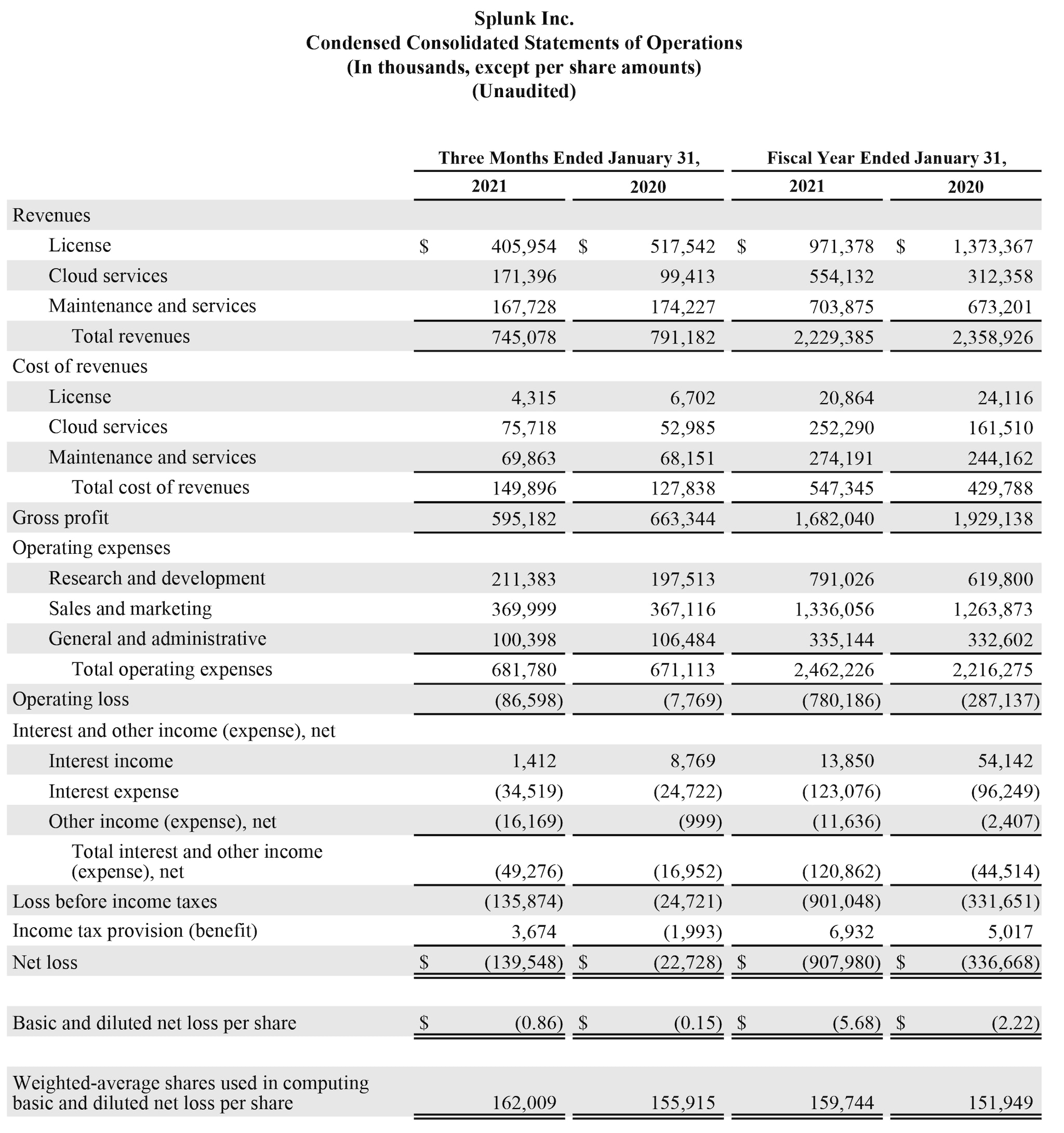
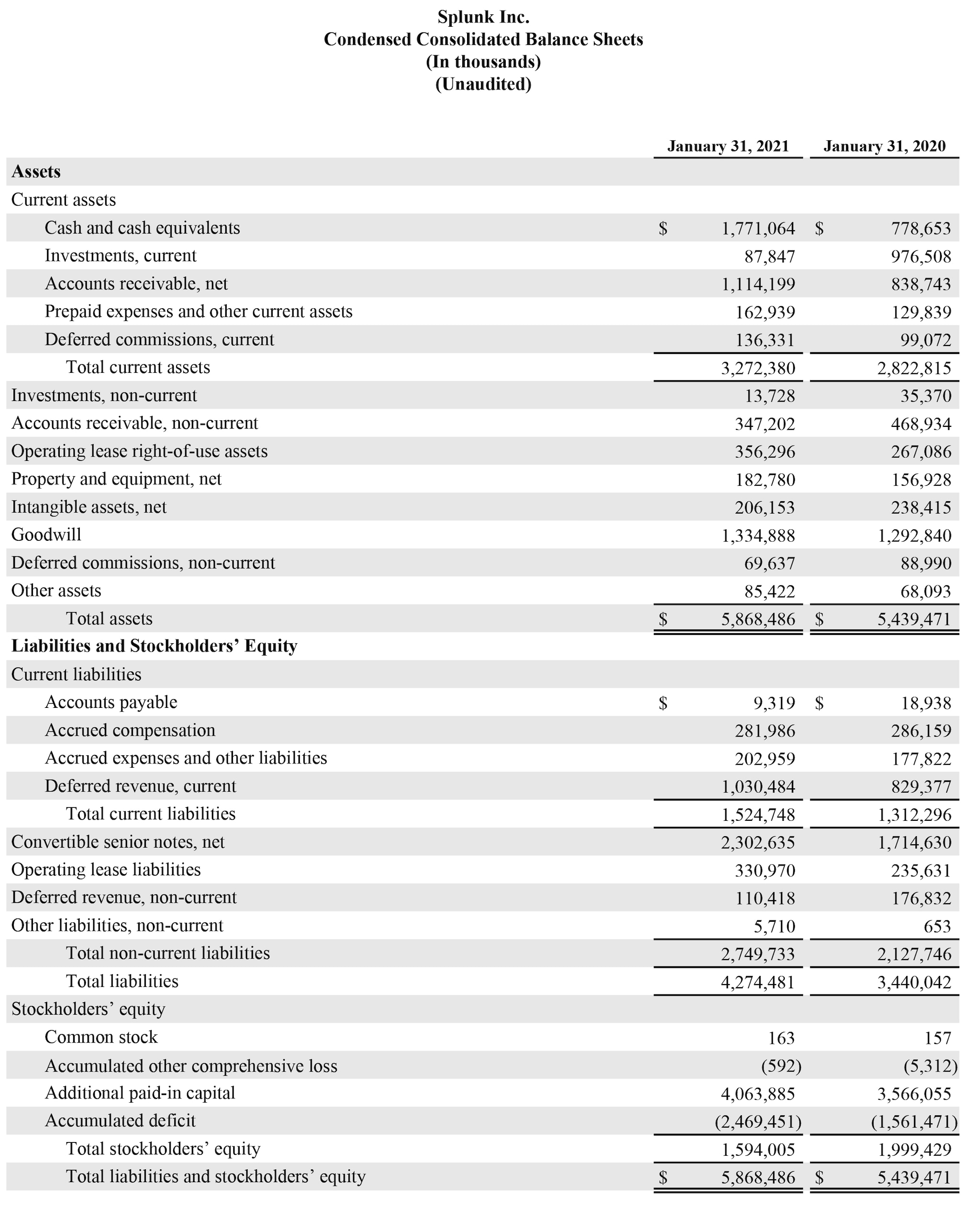
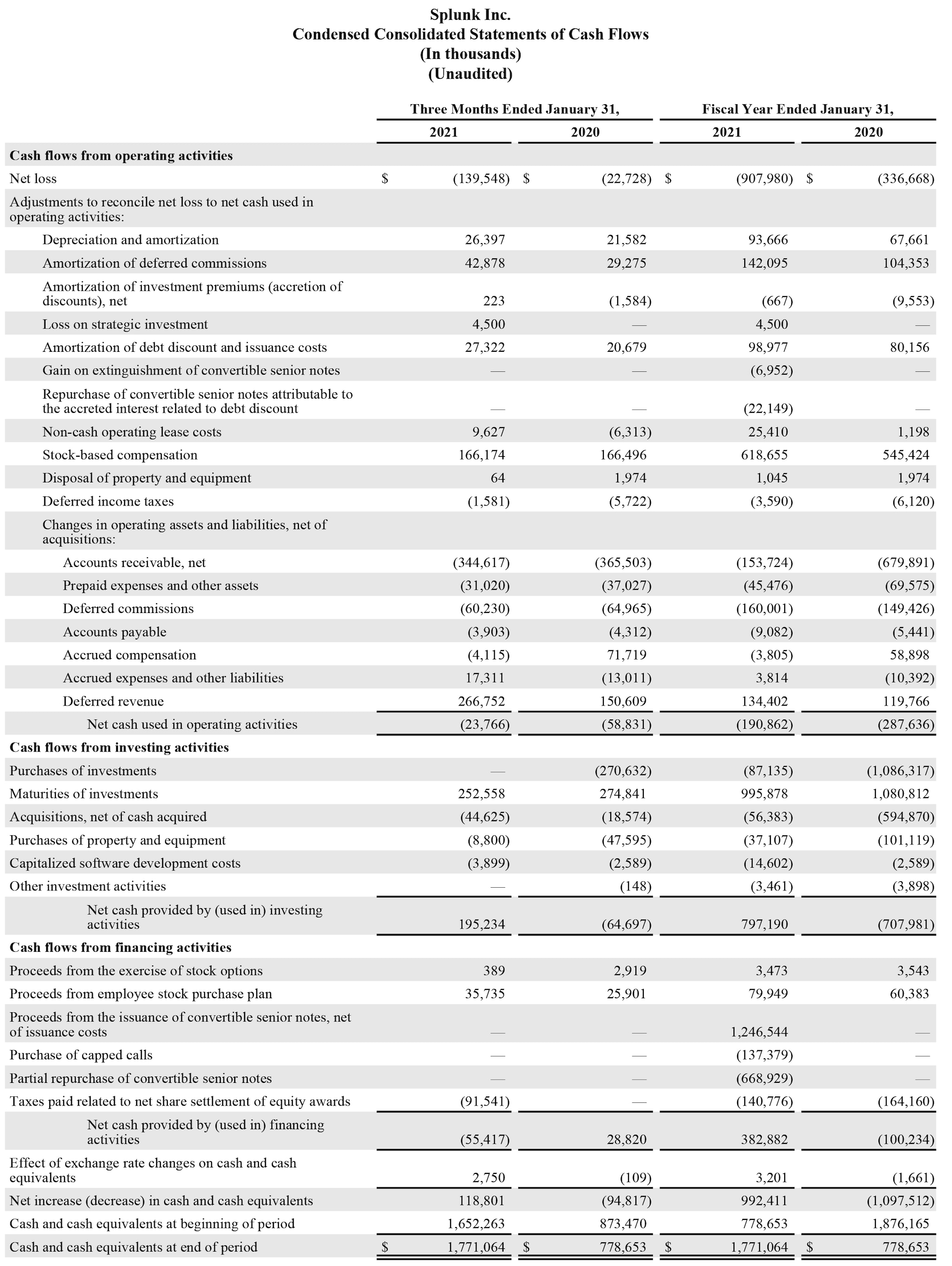
Splunk Inc.
Operating Metrics
Total Annual Recurring Revenue (“Total ARR”) represents the annualized revenue run-rate of active subscription, term license, and maintenance contracts at the end of a reporting period. Cloud Annual Recurring Revenue (“Cloud ARR”) represents the annualized revenue run-rate of active subscription contracts at the end of a reporting period. Contracts are annualized by dividing the total contract value by the number of days in the contract term and then multiplying by 365.
Non-GAAP Financial Measures and Reconciliations
To supplement Splunk’s condensed consolidated financial statements, which are prepared and presented in accordance with generally accepted accounting principles in the United States (“GAAP”), Splunk provides investors with the following non-GAAP financial measures: cloud services cost of revenues, cloud services gross margin, cost of revenues, gross margin, research and development expense, sales and marketing expense, general and administrative expense, operating income (loss), operating margin, income tax provision (benefit), net income (loss), net income (loss) per share and free cash flow (collectively the “non-GAAP financial measures”). These non-GAAP financial measures exclude all or a combination of the following (as reflected in the following reconciliation tables): expenses related to stock-based compensation and related employer payroll tax, amortization of intangible assets, restructuring and facility exit charges, acquisition-related adjustments, capitalized software development costs, a legal settlement charge, non-cash interest expense related to convertible senior notes, a gain on extinguishment of convertible senior notes and a strategic investment impairment. The non-GAAP financial measures are also adjusted for Splunk's estimated tax rate on non-GAAP income (loss). To determine the estimated non-GAAP tax rate, Splunk evaluates financial projections based on its non-GAAP results and the tax effect of those projections. The estimated non-GAAP tax rate takes into account many factors including our operating structure and tax positions. The non-GAAP tax rate applied to the three and twelve months ended January 31, 2021 was 20%. The applicable fiscal 2020 tax rates are noted in the reconciliations. In addition, non-GAAP financial measures include free cash flow, which represents operating cash flow less purchases of property and equipment. Splunk considers free cash flow to be a liquidity measure that provides useful information to management and investors about the amount of cash generated or used by the business.
Splunk excludes stock-based compensation expense because it is non-cash in nature and excluding this expense provides meaningful supplemental information regarding Splunk’s operational performance and allows investors the ability to make more meaningful comparisons between Splunk’s operating results and those of other companies. Splunk excludes employer payroll tax expense related to employee stock plans in order for investors to see the full effect that excluding that stock-based compensation expense had on Splunk’s operating results. These expenses are tied to the exercise or vesting of underlying equity awards and the price of Splunk’s common stock at the time of vesting or exercise, which may vary from period to period independent of the operating performance of Splunk’s business. Splunk also excludes amortization of intangible assets, restructuring and facility exit charges, acquisition-related adjustments, capitalized software development costs, a legal settlement charge, non-cash interest expense related to convertible senior notes, a gain on extinguishment of convertible senior notes and a strategic investment impairment from the applicable non-GAAP financial measures because these adjustments are considered by management to be outside of Splunk’s core operating results.
There are limitations in using non-GAAP financial measures because the non-GAAP financial measures are not prepared in accordance with GAAP, may be different from non-GAAP financial measures used by Splunk’s competitors and exclude expenses that may have a material impact upon Splunk’s reported financial results. Further, stock-based compensation expense has been and will continue to be, for the foreseeable future, a significant recurring expense in Splunk’s business and an important part of the compensation provided to Splunk’s employees. The presentation of the non-GAAP financial measures is not intended to be considered in isolation or as a substitute for, or superior to, the financial information prepared and presented in accordance with GAAP. Splunk uses these non-GAAP financial measures for financial and operational decision-making purposes and as a means to evaluate period-to-period comparisons. Splunk believes that these non-GAAP financial measures provide useful information about Splunk’s operating results, enhance the overall understanding of past financial performance and future prospects and allow for greater transparency with respect to key metrics used by management in its financial and operational decision making. In addition, these non-GAAP financial measures facilitate comparisons to competitors’ operating results. The non-GAAP financial measures are meant to supplement and be viewed in conjunction with GAAP financial measures.
The following tables reconcile Splunk’s GAAP results to Splunk’s non-GAAP results included in this press release.

